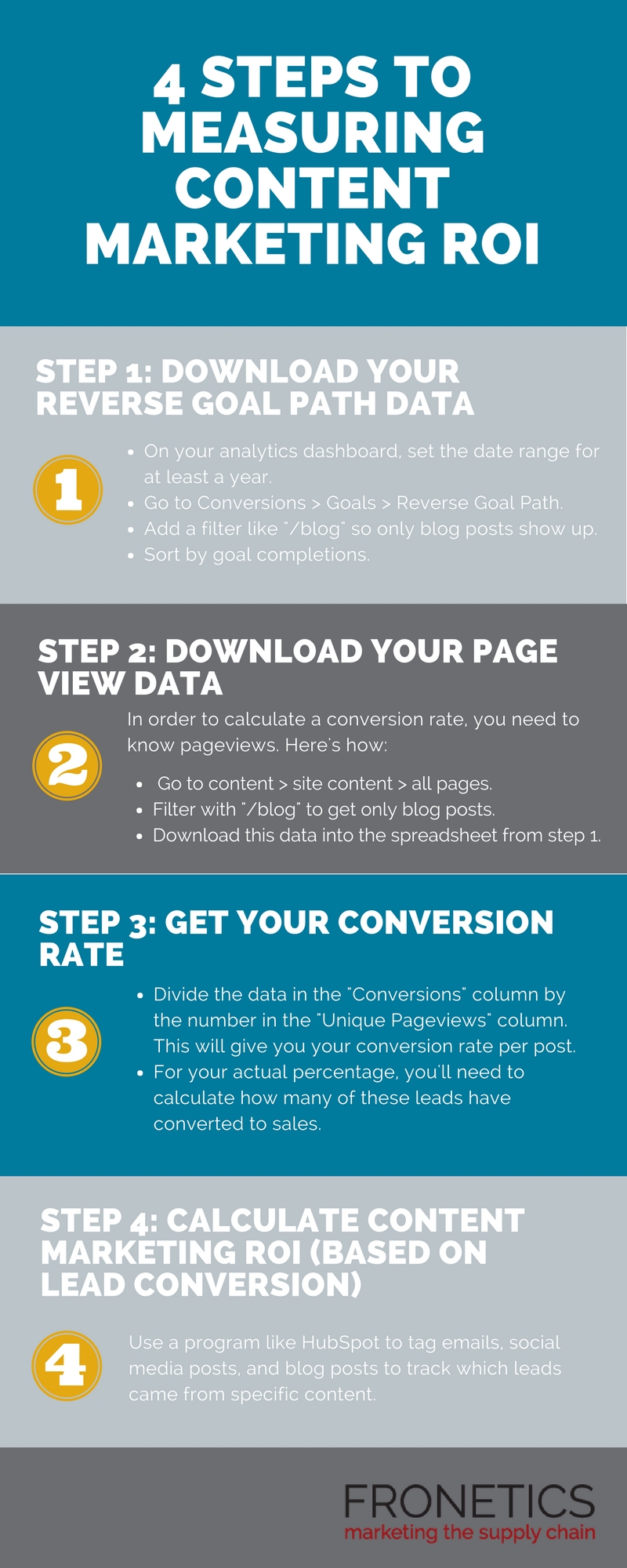
by Fronetics | Apr 18, 2018 | Blog, Content Marketing, Logistics, Marketing, Social Media, Strategy, Supply Chain
Here are four simple steps to measure your company’s content marketing ROI and the success of your content marketing strategy.
Measuring your content marketing ROI gives you valuable insight into what’s working (and what’s not) with your content marketing strategy. It’s important to measure if your efforts are profitable so you know where to put your time and money.
Content marketing ROI is harder to quantify than just tracking how many likes your social media pages have. But tracking certain metrics is important for understanding how your content marketing activities are performing. Keeping a close eye on your ROI allows you to make cost-effective marketing choices and to avoid costly mistakes.
In the article, How to Measure Content Marketing ROI: A Simple 4 Step Process, eCommerce content marketing and SEO consultant Bill Widmer breaks down the simple four-step process that will quickly — and effectively — measure your content marketing ROI.
Every company has specific key performance indicators (KPIs) that help shape their marketing strategy. These KPIs will be the foundation for measuring your content marketing ROI.
Infographic: How to measure your content marketing ROI in four easy steps

(Made with Canva)
We all want to see the fruits of our labors. Whether launching a new social media campaign or creating new videos for your blog, we look for instantaneous numbers that will affirm we made the right choices. Calculating ROI might take some time – both in the few extra minutes to do the math and the amount of time that needs to pass before all the data is available — but that number will be invaluable to you.
Want to measure your content marketing ROI?
Related posts:


by Fronetics | Apr 17, 2018 | Blog, Content Marketing, Logistics, Marketing, Social Media, Strategy, Supply Chain
Are you using subtitles as part of your YouTube marketing strategy? You should be, as well as these other tips.
I’ve written a lot about YouTube and how the supply chain should be leveraging it as a marketing tool. Of course, I don’t recommend just creating videos at random and throwing them up on your channel. Like any content or platform, you should approach YouTube strategically.
Here are some tips for optimizing your YouTube marketing strategy.
5 tips to improve your YouTube marketing strategy
1) Do the groundwork.
It may seem like a bigger-than-necessary investment of time at the front end, but doing your research is often “one of the most undervalued aspects of content marketing,” according to Forbes contributor AJ Agrawal.
This means getting a grasp of the existing landscape before you publish your content. Look at others in your market, and what works or doesn’t work for them.
2) Create “content buckets.”
“YouTube marketing really comes down to picking a few key areas where you feel you can deliver true thought leadership, entertainment, or some kind of value, and then mass-producing content that falls within those larger buckets,” says Agrawal.
“Buckets” refer to the broader categories your content falls into. For example, if you’re looking to create awareness about the role you play in a larger supply chain structure, one bucket might be education. Once you start organizing your thinking this way, generating quality content that falls within your larger strategy gets much easier.
3) Create a standard for your content, and stick to it.
Agrawal points out that one of the most important keys to building a loyal audience is consistency. This can be a challenge when it comes to posting quality video content, since it requires an investment of time and resources.
But it’s crucial that you “set the tone from the beginning and let your audience know what to expect,” including what kind of content you’ll be posting, and how often your audience can expect to hear from you. Once you’ve done that, stick with the promises you’ve made.
4) Use subtitles.
People are increasingly watching videos on their mobile devices in public, without the sound on. Taking this small step means that, rather than bypassing your content because they can’t hear what’s being said, people are paying attention to your videos no matter where they are.
5) Collaborate.
Content marketing at its very core benefits tremendously from collaboration. “One of the most effective ways to get your content disseminated, shared, and ultimately seen is by collaborating with other people who have audiences as well,” says Agrawal.
Collaborations are beneficial for everyone involved, particularly when you chose your partners strategically. If they share a similar audience, it boosts exposure for both parties, as well as boosting credibility within your industry.
Tell us about your YouTube marketing strategy.
Related posts:


by Fronetics | Apr 16, 2018 | Blog, Current Events, Strategy, Supply Chain, Talent
In the wake of the supply chain talent gap, try these strategies to fill critical positions with qualified employees and to create a pipeline of future talent.
It’s no secret — the supply chain is experiencing a major talent gap. In fact, according to Supply Chain Insights, 60% of companies within the supply chain industry have job openings, and 51% of companies are seeing an increase in turnover of supply chain leaders. So what can you do to overcome the talent shortage?
These five strategies can help companies feeling the strain of the supply chain talent gap.
5 strategies for overcoming the supply chain talent gap
1) Partner with universities and educational programs.
In an interview with Fronetics, SCM Talent Group founder Rodney Apple suggested that companies looking to attract top talent should “partner with supply chain universities and proactively recruit students from these universities, early and often.”
As more and more universities are offering supply chain degrees, these schools are a prime recruiting ground for highly qualified candidates for entry-level positions. This means “proactively reaching out to universities in the region and even nationally that match up with people in the workforce,” says Apple.
2) Be open-minded in your hiring.
A recent Google study has yielded what might be a surprising result that points to the importance of open-mindedness in hiring practices. While conventional wisdom suggests that recruiters should be focusing on STEM capabilities, it turns out that “soft skills” are often a more accurate predictor of innovation and success.
In the same vein, it’s increasingly being suggested that liberal arts grads could play an important role in the future of the supply chain. These majors emphasize the kind of critical-thinking skills that are crucial for future leadership potential.
3) Promote from within — from the manufacturing floor and beyond.
When looking to fill higher level positions, you may be overlooking a tremendously important resource: your own people. Promoting from within has several obvious advantages. Firstly, there’s institutional knowledge and trust built in — you already have relationships in place.
Promoting from within means that you’ll be placing people in higher level positions who understand the particular intricacies of your operations. This, in turn, means you save valuable time on training and eliminate what could otherwise be a steep learning curve.
4) Invest in talent acquisition.
Talent acquisition can quite literally shape the future of your company, and it’s crucial that you make it a priority. This often means working with a recruiting firm, particularly one that specializes in the supply chain.
In addition to partnering with supply chain universities, Apple suggests that companies “invest more into job training and mentoring programs, like supply chain certifications and tuition reimbursement.”
While the shortage of supply chain talent is often attributed to a skills gap, there’s a more fundamental problem: The supply chain just isn’t perceived as sexy.
“Perceptions need to change — fast,” writes Fronetics CEO and Founder Frank Cavallaro. While it won’t necessarily be easy, “convincing the public — young and old — that the manufacturing industry really is undergoing a renaissance” is ultimately the most lasting fix to combat the supply chain talent gap.
Placing the spotlight on new technologies like 3-D printing, robotics, and advanced analytics should demonstrate that the supply chain is a place for creativity, critical thinking, and fulfilling careers.
How is your company combating the supply chain talent gap?
Related posts:


by Fronetics | Apr 12, 2018 | Blog, Content Marketing, Leadership, Marketing, Social Media, Supply Chain
Make the most of your supply chain leaders’ social media accounts by following these steps.
I’ve written many times before about the importance of supply chain leaders being on social media as the face of their brands. Social media presents a huge opportunity for executives to use their relative industry celebrity to be an extension of their organizations.
So you are ready to commit to a more active social media presence (or you’re going to be ghost-posting for your executive). Where do you begin?
We’ve come up with 4 tips for supply chain leaders to making the most of their presence on social media.
4 tips for supply chain leaders on social media
1) Find the right platform (or platforms) for you.
The first thing to consider is your target audience. If you’re looking to reach a young demographic, for example, Snapchat is probably the way to go, as 45% of its users are under the age of 24. Likewise, if your brand would be well-served by live video (hint: it probably will!), Facebook Live and Instagram Stories offer great possibilities.
Next, think about your personal voice, and what type of content you are likely to be posting. Thought leadership can often best be established on LinkedIn. But that doesn’t mean that Facebook, Twitter, and YouTube aren’t also good avenues to present your voice to the world. Pick the platforms that you feel speak most to your audience and best serve your brand.
2) Use your creative side.
Supply chain and logistics leadership requires a tremendous amount of creativity and innovation. Let these qualities shine through in your social media presence! You have the tools to spark more engagement, increase follower count, and make your posts go viral.
This means using your unique voice to be a storyteller, engage your audience, and create a face for your brand. If you need some inspiration, check out these 7 Twitter accounts.
3) Create space for conversation.
Too many would-be social media mavens fall into the trap of posting the kind of content that doesn’t invite interaction. Instead, be a conversation-starter.
First, take a look at your audience and what kind of interactions they have online. You can scan the pages of other leaders in your niche as a reference point.
You can generate interaction and engagement by showing gratitude, listening to your audience, handling queries, posting thought-provoking content, and posing questions in your posts.
4) Avoid controversy.
This might seem obvious, but there’s a fine line to walk between posting or re-posting thought-provoking content and becoming an inadvertently controversial figure.
Keep in mind that, in the public platforms that are social media, all your moves will be under constant scrutiny from your fans, followers, and people in their networks. This means that while cultivating a personal voice, it’s important to maintain a level of professionalism. And stay away from posting anything that can make you a lightning rod for controversy!
Where do you go to follow supply chain leaders on social media?
Related posts:


by Fronetics | Apr 11, 2018 | Blog, Content Marketing, Logistics, Marketing, Social Media, Supply Chain
Updated December 5, 2024
Today’s B2B buyer’s journey involves more internet research and more social media use.
The B2B buyer’s journey has undergone a dramatic transformation, driven by digital innovation and changing buyer preferences. Research from Gartner shows that B2B buyers now spend only 17% of their total purchase journey time meeting directly with potential suppliers. Instead, they dedicate 27% of their time researching independently online.
Key Trends Shaping the B2B Buyer’s Journey
Digital-First Research Phase
According to TrustRadius’ 2023 B2B Buying Disconnect report, 87% of buyers want to self-serve part or all of their buying journey. This shift toward digital self-service has fundamentally changed how B2B companies must approach their marketing and sales strategies.
The Rise of Multi-Channel Engagement
Recent data from McKinsey (2023) reveals that B2B buyers regularly use ten or more channels throughout their purchase journey, compared to just five channels in 2016. This multichannel approach includes:
- Online research and comparison tools
- Social media platforms
- Peer review sites
- Virtual product demonstrations
- Video content
- Interactive webinars
The Impact of Peer Influence and Social Proof
LinkedIn’s State of B2B Marketing report highlights that 84% of B2B buyers are more likely to purchase from vendors recommended by their professional network. This emphasis on peer validation has made social proof and customer testimonials more crucial than ever.
Adapting Your Strategy to the Modern Buyer’s Journey
Content Personalization and Industry Expertise
Recent research by Salesforce indicates that 76% of B2B buyers expect vendors to understand their business needs and industry challenges specifically. This demands:
- Industry-specific content creation
- Personalized solution recommendations
- Targeted thought leadership content
- Custom ROI calculations
The Role of Digital Content in Decision Making
Content continues to play a pivotal role, but its format and delivery have evolved. According to HubSpot’s 2023 State of Marketing Report, the most effective content types now include:
- Video content (preferred by 91% of B2B buyers)
- Interactive tools and calculators
- Case studies and success stories
- Industry research and original data
- Expert webinars and virtual events
Strategic Implications for B2B Companies
Understanding the modern B2B buyer’s journey is crucial for optimizing marketing and sales efforts. Companies must:
- Invest in robust digital presence across multiple channels
- Create high-quality, industry-specific content
- Leverage social proof and customer testimonials
- Provide self-service information and tools
- Maintain consistent omnichannel engagement
The B2B buying process hasn’t necessarily shortened, but it has become more complex and digitally oriented. Success requires adapting to these changes while maintaining focus on delivering value throughout the buyer’s journey.
Infographic: the B2B buyer’s journey

The B2B buyer’s journey continues to evolve with technological advancement and changing buyer preferences. Companies that understand and adapt to these changes – by providing comprehensive digital resources, personalizing content, and enabling self-service options – will be better positioned to attract and convert modern B2B buyers.
Related posts:


by Fronetics | Apr 10, 2018 | Blog, Content Marketing, Logistics, Marketing, Strategy, Supply Chain
Check out these marketing automation tools for email workflows, social media scheduling, and customer relationship management.
Lately it seems like everyone is talking about marketing automation. As B2B buyers increasingly demand personalized experiences through the buyer’s journey, marketers’ jobs are getting tougher, as they need to provide custom lead-nurturing content to all prospects in their databases.
And that’s where automating marketing tasks can help.
The term “marketing automation” refers to a variety of tools used to automate the process of personalizing leads’ interactions with your business. The sheer variety of these tools can sometimes be overwhelming — so we’ve pulled a few of our favorites in the categories of email workflows, social media scheduling tools, and customer relationship management.
6 marketing automation tools for supply chain and logistics marketers
1. Customer.io
This tool lets you send targeted messages to your customers, crafting them based on how they interact with your business, and making personalized messages simple. You can also keep track of conversions and create customer profiles. Our favorite part? It integrates with your mobile app or website, letting you see data in real time and trigger actions by adding in predefined rules.
2. Constant Contact
This powerful tool has some features that are unique — and can take your marketing capabilities beyond the basics. Beyond setting up and managing an automated database, Constant Contact offers Facebook fan promotion, coupons and deals, and event management.
3. AdRoll
This is an extremely effective tool for retargeting customers through re-engagement on Facebook, Twitter, and elsewhere on the web. It offers cross-device and cross-platform retargeting capabilities, as well as flexible segmentation, letting you provide customized experiences that dramatically improve your marketing efficiency. It also offers customized budgeting and full control over ad spend.
4. Pardot
Pardot is an all-inclusive marketing automation suite, but it’s particularly strong for amping up your engagement with CRM integration. It’s a great tool for helping your sales team shorten the sales cycle. And, in addition to CRM integration, it offers email marketing, lead nurturing, lead scoring, and ROI reporting.
5. Marketo
This cloud-based marketing software lets you drive revenue with lead management and mobile marketing. It not only helps build customer relationships, but it helps you sustain them as well. Best of all, you can try it out for free until you’re sure it’s right for your business.
Bonus all-in-one tool: HubSpot
HubSpot is an inbound-marketing tool that lets you generate leads, close deals, and manage your sales pipeline from start to finish. It integrates beautifully with a content marketing strategy, with the goal of turning outbound leads into inbound ones. It includes revenue reporting, custom-event reporting, custom-event automation triggers, predictive-lead scoring, contacts and company reporting, and event-based segmentation.
What marketing automation tools does your business use?
Related posts:













